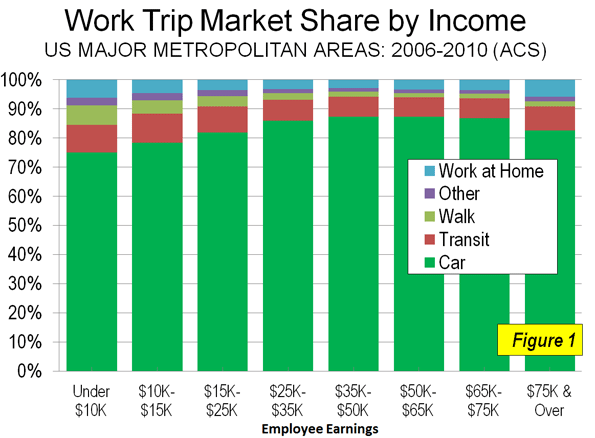
Portland is a PR machine for light rail & streetcar
Here are Some Facts About Portland Oregon
“It must always be remembered how cost-effectiveness works in the public sector: the cost IS the benefit.” - author unknown
How Lower Income Citizens Commute
One of the most frequently recurring justifications for densification policies (smart growth, growth management, livability, etc.) lies with the assumption that the automobile-based mobility system (Note 1) disadvantages lower income citizens. Much of the solution, according to advocates of densification is to discourage driving and orient both urbanization and the urban transportation system toward transit as well as walking and cycling.
Of course, there is no question but that lower income citizens are disadvantaged with respect to just about everything economic. However, there are few ways in which lower income citizens are more disadvantaged than in their practical access to work and to amenities by means of transit, walking and cycling. Indeed, the impression that lower income citizens rely on transit to a significantly greater degree than everyone else is just that – an impression.
The Data: This is illustrated by a compilation of work trip data from the five-year American Community Survey for 2006 to 2010. In the nation's 51 major metropolitan areas (more than 1,000,000 population), 76.3% of lower income employees use cars to get to work, three times that of all other modes combined (Figure 1).
Admittedly, this is less than the 83.3% of all employees who use cars for the work trip, but a lot more than would be expected, especially among those who believe that transit is the principal means of mobility for low income citizens. Overall, 8 times as many lower income citizens commuted by car as by transit. In this analysis, lower income citizens are defined as employees who earn less than $15,000 per year, which is approximately one-half of the median earnings per employee of $29,701. .
Perhaps most surprising is the fact that only 9.6% of lower income citizens used transit to get to work. This is not very much higher than the 7.9% of all workers in the metropolitan areas who use transit. (Table 1).

Read the whole article at New Geography
111111111111111111111
| Bribery |
| Cheaper & Better Transit |
| EuroTranistShareLoss |
| Elderly Travel |
| GM & The Streetcar |
| Commute Time Chart |
| Top 10 Bus |
| Clackamas Public Safety |
| transit_congestion |
| McLoughlin Plan |
| CRC_Planning |
| Zoneing Increases Cost, Hurts Economy |
| High Rise |